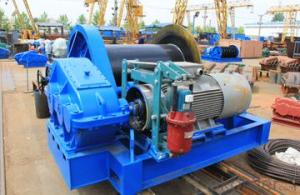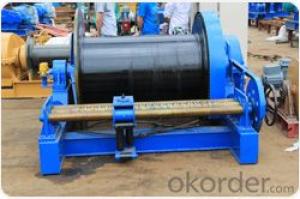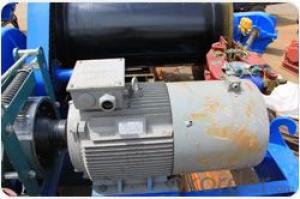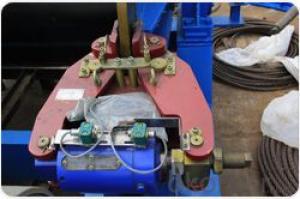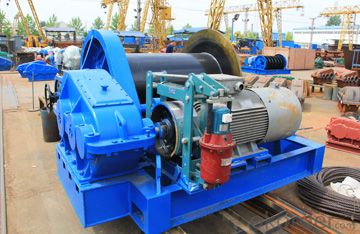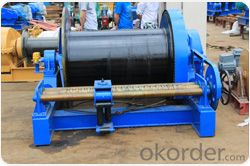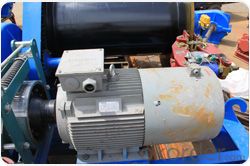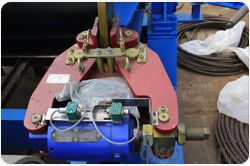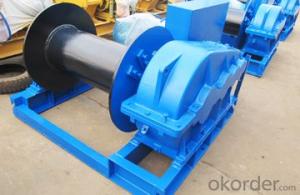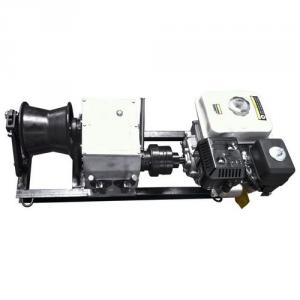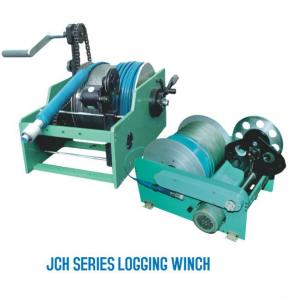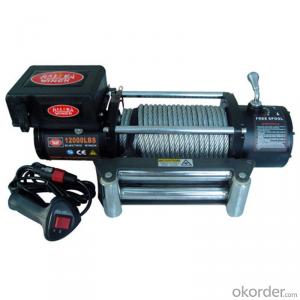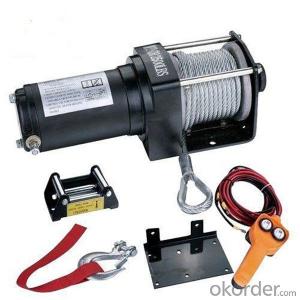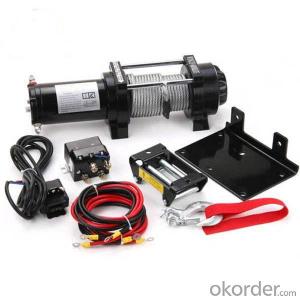Fast Speed Electric Winch
- Loading Port:
- Shanghai
- Payment Terms:
- TT OR LC
- Min Order Qty:
- 1 unit
- Supply Capability:
- 30 unit/month
OKorder Service Pledge
OKorder Financial Service
You Might Also Like



This series is fast speed electric motor driven gear winch; It is mainly used on construction engineering for hoisting; drag-and-drop cargos; overhead cranes, gantry cranes for lifting, headframe for hoisting;
The winches are applied to construction company, mine, factory and other installation engineering projects company, and other small equipments installation work;
Technical Data:
Rated Load | Average Speed of Rope | Capacity of Rope | Rope Diameter | Motor Power | Overall Dimension | Total Weight | |
Model | KN | m/min | m | mm | KW | mm | kg |
JK0.5 | 5 | 22 | 190 | 7.7 | 3 | 620×701×417 | 200 |
JK1 | 10 | 22 | 100 | 9.3 | 4 | 620x701x417 | 300 |
JK1.6 | 16 | 24 | 150 | 12.5 | 5.5 | 945×996×570 | 500 |
JK2 | 20 | 24 | 150 | 13 | 7.5 | 945x996x570 | 500 |
JK3.2 | 32 | 25 | 290 | 15.5 | 22 | 1325x1335x840 | 1011 |
JK3.2B | 32 | 30 | 250 | 15.5 | 22 | 1900x1738x985 | 1500 |
JK5 | 50 | 30 | 300 | 21.5 | 30 | 1900x1620x985 | 2050 |
JK5B | 50 | 25 | 210 | 21.5 | 22 | 2250x2500x1300 | 2264 |
JK8 | 80 | 25 | 160 | 26 | 45 | 1533x1985x1045 | 3000 |
JK10 | 100 | 30 | 300 | 30 | 55 | 2250x2500x1300 | 5100 |
- Q: This question asks about the regular maintenance tasks needed to keep hydraulic pumps in building hoists functioning properly.
- <p>Maintenance requirements for hydraulic pumps in building hoists include regular inspection of the pump for leaks, wear, and proper lubrication. It's crucial to check the hydraulic oil level and quality, ensuring it's clean and at the correct level. The oil should be changed periodically as per the manufacturer's recommendations. Inspect the pump for any unusual noises or vibrations which could indicate wear or damage. Regularly clean the filter to prevent blockages and ensure efficient operation. Additionally, check the pump's pressure and flow rate to confirm it's operating within the specified parameters. Following the manufacturer's maintenance schedule and guidelines is essential to prolong the life of the hydraulic pump and ensure the safety and efficiency of the building hoist.</p>
- Q: Is it possible to fix a building hoist or substitute it with alternative lifting machinery?
- <p>Yes, a building hoist can be repaired if the damage is not severe. If repair is not feasible or cost-effective, it can be replaced by other types of lifting equipment. There are various alternatives available, such as cranes, forklifts, and material hoists, each with its own advantages and suitable for different scenarios. The choice depends on factors like the weight of the load, the height of the building, and the specific requirements of the construction project. It's essential to consider safety, efficiency, and compatibility with the existing infrastructure when making such decisions.</p>
- Q: Is it possible to use a building hoist to lift objects that are too large to pass through a standard doorway?
- <p>Yes, a building hoist can be used for lifting objects that are too large to fit through a doorway. Building hoists are designed to handle heavy and oversized items, lifting them vertically through small openings or directly from the ground to higher floors. They are particularly useful in construction projects where large materials or equipment need to be moved to upper levels of a building. However, it's important to ensure the hoist is properly installed and operated by trained personnel to maintain safety and avoid damage to the building or the items being lifted.</p>
- Q: The user is asking if it's possible to use a building hoist, typically used for construction, to lift a car.
- <p>Using a building hoist to lift a car is not recommended. Building hoists are designed for lifting materials and equipment in construction settings, not for vehicles. They may not have the appropriate safety features or load-bearing capacity for a car. Attempting to lift a car with a building hoist could result in damage to the car, the hoist, or even personal injury. For lifting a car, it's best to use a vehicle-specific lift or a hydraulic lift designed for such purposes, ensuring safety and proper support.</p>
- Q: This question asks for the method to determine the maximum weight a building hoist can lift.
- <p>The lifting capacity of a building hoist is calculated by considering several factors including the hoist's motor power, the strength of the hoist's construction materials, and the safety factor. The manufacturer usually provides the maximum lifting capacity based on these factors. To calculate it manually, you would need to know the motor's lifting force, the efficiency of the hoist's mechanical system, and apply a safety factor to ensure the hoist operates within safe limits. It's important to follow the manufacturer's guidelines and never exceed the specified lifting capacity to prevent accidents and ensure the hoist's longevity.</p>
- Q: Why do you ask the construction elevator to be a certain distance from the structure? Is very close to if not you can not bother to do delivery channel security protection or something, out of the elevator out directly, and attachment should be able to get more easily, to solve. Thank you very much!!
- The distance between the moving parts and the building and the fixed construction equipment shall not be less than 0.25 m. The main thing is to prevent the person from the point of view. For example, workers are on the third floor to look down, hanging cage, where is the result now hanging basket is go down from the fourth floor, if not the 25 cm, likely to brush "cut".
- Q: The construction of more than many floors must be used for construction elevators
- Elevator drivers must be trained in special safety technology, qualified for examination, and will be on duty. Strict drunken work. The driver must be familiar with the performance, construction, maintenance and maintenance of the elevator, and fill in the mechanical resume and the required reports in time. No inflammable, flammable goods and other sundries shall be piled up in the vicinity of 5m in the construction elevator, and no ditch, pits, or groove shall be dug in this area. The floor feed of the elevator should be set up for protection. When the cage is repaired, if the parts are removed and the weight of the ladder is below the weight, the ladder cage must be locked in the rail. It is strictly forbidden to use the shaft of the construction elevator to support the cable line and other items not related to the elevator. A tower crane or other lifting machine that is built on the same site shall be more than 5m above the elevator and should be properly protected against collision. After the construction elevator is installed, it must be checked and approved by the relevant personnel.
- Q: This question asks for criteria to differentiate between electric and hydraulic building hoists for selection based on specific needs.
- <p>When choosing between electric and hydraulic building hoists, consider the following: 1) Power Source: Electric hoists require a reliable electricity supply while hydraulic hoists need a power source for the hydraulic pump. 2) Lifting Capacity: Electric hoists often have higher lifting capacities. 3) Speed: Electric hoists generally offer faster lifting and lowering speeds. 4) Maintenance: Hydraulic hoists may require more frequent maintenance due to fluid changes and potential leaks. 5) Noise: Electric hoists are quieter. 6) Cost: Initial costs and operating expenses should be compared. 7) Safety: Both types have safety features, but electric hoists might offer more advanced safety options. 8) Environmental Factors: Consider weather conditions; electric hoists are less affected by rain and cold. Your choice should align with the project's specific requirements, such as the weight of materials to be lifted, frequency of use, and environmental conditions.</p>
- Q: Explain the key differences between electric and pneumatic lifting equipment in a few sentences.
- <p>Electric lifting equipment is powered by electricity and offers precise control, high efficiency, and is suitable for heavy-duty applications. Pneumatic lifting equipment, on the other hand, is powered by compressed air and is known for its simplicity, safety, and lower cost. It is often used in environments where electrical equipment might be hazardous, such as in the presence of flammable gases or dust. Electric systems can handle heavier loads and provide more precise control, while pneumatic systems are more resistant to overload and offer a fail-safe mechanism in case of air pressure loss.</p>
- Q: What is the purpose of a building hoist and can it be utilized for lifting heavy objects that cannot be manually lifted?
- <p>Yes, building hoists are specifically designed to lift heavy objects that are beyond the capacity of manual lifting. They are essential in construction sites for moving materials such as bricks, cement, and steel beams to various levels of a building. Building hoists are engineered to handle significant weight and ensure the safe and efficient transport of materials, reducing the risk of injury and improving productivity on construction sites.</p>
Send your message to us
Fast Speed Electric Winch
- Loading Port:
- Shanghai
- Payment Terms:
- TT OR LC
- Min Order Qty:
- 1 unit
- Supply Capability:
- 30 unit/month
OKorder Service Pledge
OKorder Financial Service
Similar products
Hot products
Hot Searches
Related keywords
